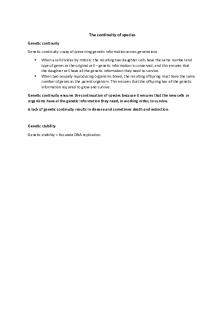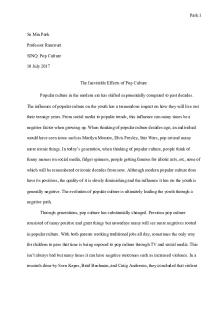Pond Ecosystem Project The effects of Potassium Phosphate PDF

| Title | Pond Ecosystem Project The effects of Potassium Phosphate |
|---|---|
| Course | Orgnc/Biol Chemistry Ii |
| Institution | University of Alaska Anchorage |
| Pages | 9 |
| File Size | 364.7 KB |
| File Type | |
| Total Downloads | 93 |
| Total Views | 151 |
Summary
Not uploaded via Turnitin. ...
Description
Pond Ecosystem Project: The effects of Potassium Phosphate University of Alaska Anchorage Dylan Blankenship Bio 611 December 9th 2015
Abstract: With my group I created two simulations of a pond ecosystem using water from Goose Lake, ordered materials from the lab and jars. The first jar
we left to its own means as it would be our control group. The other jar we added Potassium Phosphate to see the effects it has on a local pond environment.
The goal of the project was to find out the effects of Potassium Phosphates on important local environments like lakes and ponds. Lakes and ponds are a massive staple in the ecosystem of Anchorage. These bodies of
water are breeding grounds for important insects, food sources for many species of birds, and of course play into the lifecycle of many hyperlocal species such as moose. Potassium Phosphates are a common agent found in fertilizers with uses common in anything from an industrial greenhouse to your mother's garden. It is quite easy for Potassium Phosphates to contaminate groundwater and be incorporated into lakes and ponds. With this situation becoming more and more prevalent this experiment seemed necessary to fully observe the effects one can expect when a pond is contaminated with the common fertilizer Potassium Phosphate.
To carry out this experiment we used the following materials:
•2 Stalks - Fresh Water Plant •1 - Snail •1 - Shrimp •600mls - Goose Lake Pond Water •100mls - Gravel •150mls - Dirt •5 pieces - Rock •5.5ml - Plankton Mix These materials were used in creating both jars. The experimental jar called for 18g of Potassium Phosphate along with this. The first step was to create a sustainable ecosystem in both jars. We did this by layering the material in the same order they would be found in the wild. First the dirt,
then the gravel and rocks. The plant firmly rooted in the dirt. We then added the Goose Lake water followed by all the lifeforms. For the experimental group we added the Phosphate last. Every week we would take data on both ecosystems. Observing the lifeforms under a microscope, taking PH levels, measuring the amount of water that disappeared and simply how healthy it looked. This was done over a course of four weeks. Here are both the ecosystems on the first week:
Control
Experimental
Compared to the fourth week:
Control
Experimental
The results from visual observation already show that the experimental group has a much more vibrant plant life, compared to the control group in which the plants were not visible due to the amount of muck floating about. More importantly is the numbers behind this, how did the lifeforms fare?
Throughout the course of this experiment we noted four organisms that were the same creature in both habitats. These were the ones we would compare as it would give us the best indication; how the same creature would survive in both the control and experimental groups. This data shows that organisms C and A did poorly in both environments. Using this data the conclusion is drawn that the control group followed a trend that is more natural. With the organism that survives best in this environment showing the best results, organism D. The experimental group showed that the addition of phosphates kept the D organism at normal levels while also allowing organism B to survive as well. This is possible because B lived off of plant life, while D lived off other organisms. This is also why in the control group B is the only organism left remaining.
While D did well in both environments. Organism
B only did well in the experimental group. Not shown on this graph re the lifeform observable by the naked eye. The plant only survived in the experimental group, the snails and shrimp died in botch.We can conclude from this data that the addition of phosphate can foster the amount of life in a pond ecosystem, however this is a double edged sword. If one organism grows in population too much due to the phosphate I hypothesize that it would overwhelm the natural resources causing a collapse of the food chain and ultimately life in the pond....
Similar Free PDFs

THE EFFECTS OF CORRUPTION
- 5 Pages

Effects of the Sugar REvolution
- 4 Pages

Components of Ecosystem
- 12 Pages

The Negative Effects of Video Games
- 16 Pages
Popular Institutions
- Tinajero National High School - Annex
- Politeknik Caltex Riau
- Yokohama City University
- SGT University
- University of Al-Qadisiyah
- Divine Word College of Vigan
- Techniek College Rotterdam
- Universidade de Santiago
- Universiti Teknologi MARA Cawangan Johor Kampus Pasir Gudang
- Poltekkes Kemenkes Yogyakarta
- Baguio City National High School
- Colegio san marcos
- preparatoria uno
- Centro de Bachillerato Tecnológico Industrial y de Servicios No. 107
- Dalian Maritime University
- Quang Trung Secondary School
- Colegio Tecnológico en Informática
- Corporación Regional de Educación Superior
- Grupo CEDVA
- Dar Al Uloom University
- Centro de Estudios Preuniversitarios de la Universidad Nacional de Ingeniería
- 上智大学
- Aakash International School, Nuna Majara
- San Felipe Neri Catholic School
- Kang Chiao International School - New Taipei City
- Misamis Occidental National High School
- Institución Educativa Escuela Normal Juan Ladrilleros
- Kolehiyo ng Pantukan
- Batanes State College
- Instituto Continental
- Sekolah Menengah Kejuruan Kesehatan Kaltara (Tarakan)
- Colegio de La Inmaculada Concepcion - Cebu











